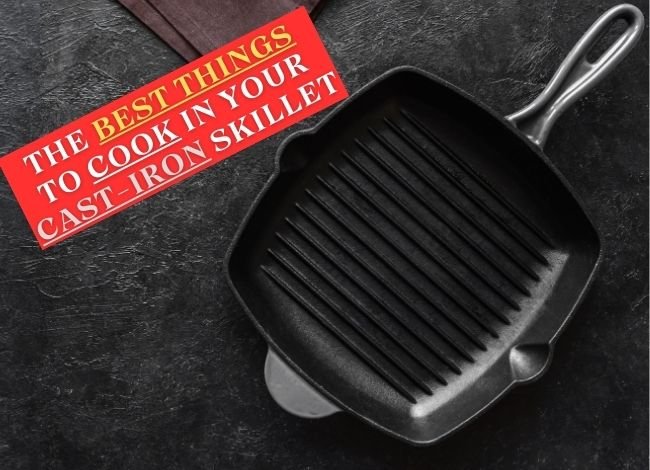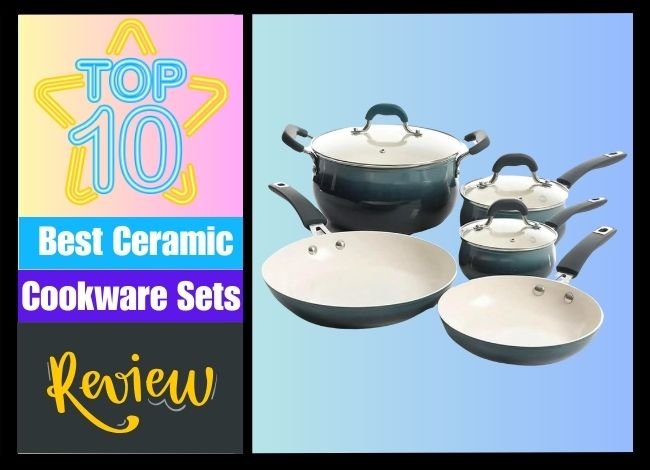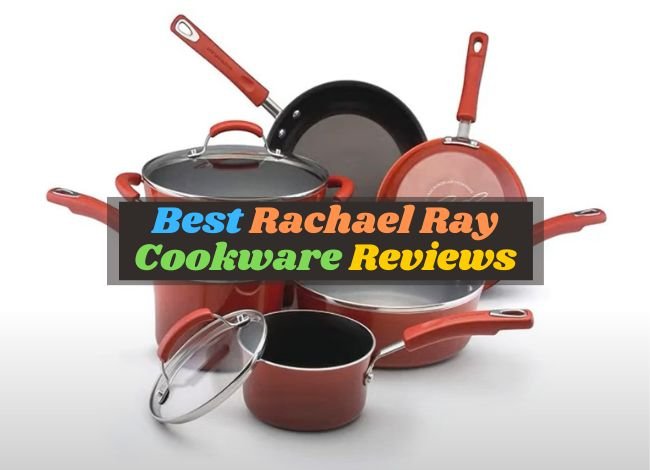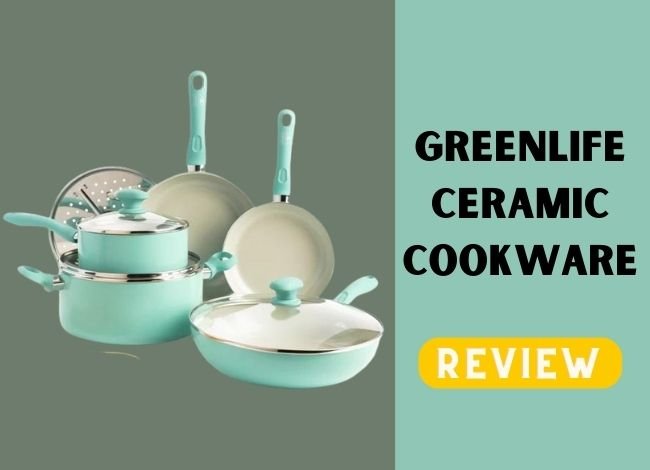Last Updated on February 7, 2024
The cast-iron skillet is a versatile kitchen tool that has stood the test of time. It is beloved by chefs and home cooks alike for its unmatched ability to distribute and retain heat evenly. This makes it perfect for a wide range of cooking techniques, from searing to baking. Here, we dive into the best things to cook in your cast-iron skillet, focusing on its searing capabilities and convenience as a one-pan wonder.
Searing
One of the cast-iron skillet’s most celebrated uses is for searing. The skillet’s ability to get extremely hot and stay hot makes it ideal for creating a perfect sear on meats. When you sear meat in a cast-iron skillet, you’re not just cooking it; you’re enhancing its flavor and texture. The high heat allows for the Maillard reaction, a chemical process that browns the meat and creates a complex flavor profile that can’t be achieved with lower temperatures.
Heat up your skillet on the stove over medium-high to high heat for several minutes to get the best sear. Once hot, add a thin layer of oil with a high smoke point, like canola or grapeseed, and then add your meat. Don’t overcrowd the skillet, as this can lower the temperature and prevent proper searing. Let the meat cook undisturbed for a few minutes until it develops a dark, crisp crust, then flip it to sear the other side. Whether it’s a thick steak, pork chops, or chicken breasts, the result is a beautifully browned exterior and a juicy, tender interior that’s full of flavor.
One-Pan Wonder
The cast-iron skillet shines not only in searing but also as a one-pan wonder, capable of creating a multitude of dishes with minimal cleanup. This characteristic makes it a favorite for busy cooks looking to simplify their meal preparation without sacrificing quality. From savory frittatas, skillet cookies, to deep-dish pizzas, the cast-iron skillet can handle it all.
Its ability to go from stovetop to oven makes it incredibly versatile. For example, you can start a frittata on the stove, sautéing vegetables and meats, then add beaten eggs and transfer the skillet to the oven to finish cooking. Similarly, skillet cookies can be prepared by mixing and baking the dough in one pan, creating a delightful, simple, and delicious treat.
The skillet’s even heat distribution is perfect for cooking pizzas, giving you a crispy crust that’s hard to achieve with a regular baking sheet. And because of its heat retention, dishes stay warm for a longer period, making the skillet ideal for serving straight to the table. The durability of cast iron means that with proper care, your skillet can last a lifetime, becoming more non-stick over time. This longevity, coupled with its cooking efficiency, makes the cast-iron skillet a staple in kitchens worldwide.
Frying
When it comes to frying, the cast-iron skillet stands out as a superior choice for chefs and home cooks alike. Its ability to retain and evenly distribute heat makes it ideal for achieving that perfect, golden-brown crust on everything from chicken to French fries. Unlike other cookware, a well-seasoned cast-iron skillet enhances the flavor of your food, adding a depth of taste that can’t be matched. This skillet is not just for meats; vegetables also benefit from the skillet’s high heat capabilities, turning out crispy and flavorful without the need for a deep fryer.
Moreover, cast iron’s durability means that it can withstand the high temperatures needed for frying without warping or deteriorating, ensuring that every meal is perfectly cooked. Proper heat management is one of the secrets to successful frying in a cast-iron skillet. Start with a moderate heat to warm the skillet and then adjust accordingly based on the food you are cooking. This method helps to prevent sticking and ensures that food cooks evenly.
Additionally, the natural non-stick surface that develops over time with proper seasoning reduces the need for excessive oil, making for healthier cooking options. Whether you’re crafting the perfect fried chicken or crispy tofu, a cast-iron skillet delivers unmatched results that will impress any diner.
Caramelizing
The cast-iron skillet is a powerhouse when it comes to caramelizing. Its exceptional heat retention and even distribution provide the perfect conditions for browning sugars in foods, resulting in a depth of flavor and texture that can elevate any dish. The skillet’s capabilities are vast, from onions that melt into a sweet, savory foundation for soups and sauces to fruits that transform into rich, complex toppings or dessert bases.
Caramelizing in cast iron requires patience and attention, as the skillet’s steady heat encourages sugars to break down and brown without burning. This process, known as the Maillard reaction, not only enhances the visual appeal of food with its rich, golden color but also builds layers of flavor that can’t be achieved through other cooking methods. A tip for achieving the best caramelization is to avoid overcrowding the skillet, which allows each piece of food to come into direct contact with the hot surface, ensuring even browning and a perfect finish.
Furthermore, the versatility of the cast-iron skillet means that it can go from stovetop to oven, allowing for greater control over the cooking process. This is especially useful for dishes that benefit from a slow, gentle finish in the oven after an initial sear or caramelization on the cooktop. Whether you’re working with vegetables, meats, or desserts, mastering the art of caramelization with a cast-iron skillet can transform simple ingredients into culinary masterpieces.
Baking
Baking in a cast-iron skillet opens up a world of culinary possibilities, from savory cornbread and frittatas to sweet pies and cakes. The skillet’s ability to go from stovetop to oven makes it incredibly versatile for baking. Its excellent heat retention ensures that baked goods cook evenly, with a desirable crust that is often hard to achieve with traditional bakeware.
The cast-iron skillet is not just for traditional stovetop cooking; it excels in the oven, where its even heat distribution can make a noticeable difference in the texture and flavor of baked goods. Whether you’re making a skillet cookie that’s gooey in the middle and crisp around the edges or a deep-dish pizza with a perfectly browned crust, the skillet delivers consistent results. Additionally, the more you bake with your cast-iron skillet, the better it performs. The oils and fats from baking contribute to the skillet’s seasoning, enhancing its natural non-stick properties and infusing a subtle flavor into every dish.
To get the most out of baking with cast iron, it’s important to preheat the skillet just as you would the oven. This step ensures that the batter or dough starts cooking as soon as it hits the pan, creating a beautifully crisp exterior. Moreover, caring for your cast-iron skillet is straightforward, requiring only a quick wash, thorough drying, and a light oiling to maintain its condition. Embracing the cast-iron skillet for baking can revolutionize how you think about desserts and bread, proving that this kitchen workhorse can do much more than just frying and sautéing.
What Can’t It Do?
The cast-iron skillet is often celebrated for its versatility, but it’s worth noting there are few things it can’t do. While it excels at frying, caramelizing, and baking, the skillet’s interaction with highly acidic foods is one of its few limitations. Cooking dishes with tomato sauce, vinegar, or lemon juice over prolonged periods can strip the skillet of its seasoning and lead to a metallic taste in food. However, this doesn’t mean these dishes are entirely off-limits; they simply require a bit of caution and moderation in their preparation.
Despite its heft, the cast-iron skillet can be less ideal for quick, delicate tasks that require tossing and flipping with ease, such as sautéing light vegetables or making crepes. Yet, even these limitations can be overcome with practice for those willing to adapt their techniques. The key to unleashing the full potential of your cast-iron skillet lies in understanding its properties and how to care for it properly. Regular seasoning and maintenance ensure that it remains a reliable tool in your culinary arsenal, capable of cooking almost anything to perfection.
Cooks can unlock a world of culinary possibilities by embracing the strengths and learning to work around the few limitations of the cast-iron skillet. Whether you’re a seasoned chef or a home cooking enthusiast, the cast-iron skillet is a testament to the beauty of simplicity in the kitchen, proving that sometimes, the oldest tools can be the most powerful.
Conclusion
The cast-iron skillet is a powerhouse of versatility in the kitchen, ideal for searing meats to perfection and serving as a one-pan wonder for an array of dishes. Its ability to distribute and retain heat evenly makes it indispensable for cooks who value both flavor and convenience. Whether you’re a seasoned chef or a home cook, incorporating a cast-iron skillet into your culinary repertoire opens up a world of possibilities for elevating your cooking game. So, grab your skillet, and let’s get cooking!




